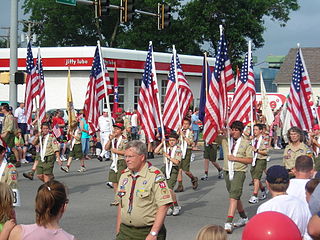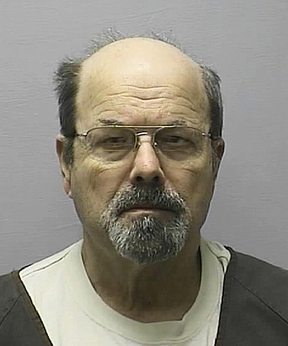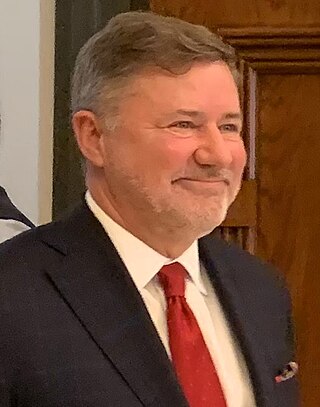Related Research Articles

Scouting in Oklahoma has a long history, from the 1910s to the present day, serving thousands of youth in programs that suit the environment in which they live.
Locust Grove is a town in Mayes County, Oklahoma, United States. The population was 1,423 at the 2010 census, a 4.2 percent increase over the figure of 1,366 recorded in 2000.

Dennis Lynn Rader, also known as BTK, is an American serial killer who murdered at least ten people in Wichita and Park City, Kansas, between 1974 and 1991. Although Rader occasionally killed or attempted to kill men and children, he typically targeted women. His victims were often bound, sometimes with objects from their homes, and either suffocated with a plastic bag or manually strangled with a ligature.

The Lake Bodom murders is one of the most infamous unsolved homicide cases in Finnish criminal history. On 5 June 1960, at Lake Bodom in Espoo, Uusimaa, Maila Björklund and Anja Mäki and Seppo Boisman (18) were killed by stabbing and blunt-force trauma to their heads while sleeping inside a tent. The fourth youth, Nils Gustafsson, then aged 18, was found outside the tent with broken facial bones and stab wounds. Despite extensive investigations, the perpetrator was never identified and various theories on the killer's identity have been presented over the years. Gustafsson was unexpectedly arrested on suspicion of committing the murders in 2004, but he was found not guilty the following year.
The 1991 Austin yogurt shop killings are an unsolved quadruple homicide which took place at an I Can't Believe It's Yogurt! shop in Austin, Texas, United States on Friday, December 6, 1991. The victims were four teenage girls: 13-year-old Amy Ayers, 17-year-old Eliza Thomas, 17-year-old Jennifer Harbison and Jennifer's 15-year-old sister Sarah. Jennifer and Eliza were employees of the shop, while Sarah and her friend Amy were in the shop to get a ride home with Jennifer after it closed at 11:00 pm. Approximately one hour before closing time, a man who had tried to hustle customers in his queue was permitted to use the toilet in back, took a very long time and may have jammed a rear door open. A couple who left the shop just before 11:00 pm, when Jennifer locked the front door to prevent more customers entering, reported seeing two men at a table acting furtively.

Harvey Phillip Pratt is an American forensic artist and Native American artist, who has worked for over forty years in law enforcement, completing thousands of composite drawings and hundreds of soft tissue postmortem reconstructions. To this end, his work has assisted in thousands of arrests and hundreds of identification of unidentified human remains throughout America. His expertise in witness description drawing, skull reconstruction, skull tracing, age progression, soft tissue postmortem drawing and restoration of photographs and videos have aided law enforcement agencies both nationally and internationally. Pratt also assists investigations through training classes, besides lecturing before universities, colleges, schools and civic groups. In the early 2000s Pratt teamed up with David Paulides in researching Bigfoot on the Hoopa Reservation in California, as well as in his home state of Oklahoma.

Charles Troy Coleman was an American convicted murderer and suspected serial killer who was executed in 1990 by the state of Oklahoma. He was convicted in 1979 of the murder of John Seward, who, along with his wife, was killed by a shotgun blast in rural Muskogee County, when they interrupted a robbery at a relative's house. He also murdered Russell E. Lewis in a fatal carjacking in 1979 and is suspected of murdering the father of his former girlfriend in 1975. Despite killing at least three people, he was never convicted of the murder of Seward's wife and his sentence for Lewis's murder was overturned.

The World's End Murders is the colloquial name given to the murder of two girls, Christine Eadie, 17, and Helen Scott, 17, in Edinburgh, in October 1977. The case is so named because both victims were last seen alive leaving The World's End pub in Edinburgh's Old Town. The only person to stand trial accused of the murders, Angus Robertson Sinclair, was acquitted in 2007 in controversial circumstances. Following the amendment of the law of double jeopardy, which would have prevented his retrial, Sinclair was retried in October 2014 and convicted of both murders on 14 November 2014. He was sentenced to life imprisonment with a minimum term of 37 years, the longest sentence by a Scottish court, meaning he would have been 106 years old when he was eligible for a potential release on parole. He died at HM Prison Glenochil aged 73 on 11 March 2019. Coincidentally, he died on the same day the BBC's Crimewatch Roadshow programme profiled the murders.
In 2008, there were 145,144 crimes reported in the U.S. state of Oklahoma, including 212 murders. In 2014, there were 131,726 crimes reported, including 175 murders.

The Villisca axe murders occurred between the evening of June 9, 1912, to the early morning of June 10, 1912; in the town of Villisca, Iowa, in the United States. The six members of the Moore family and two guests were found bludgeoned in the Moore residence. All eight victims, including six children, had severe head wounds from an axe. A lengthy investigation yielded several suspects, one of whom was tried twice. The first trial ended in a hung jury and the second ended in an acquittal.
As of December 22, 2022, Oklahoma has been impacted more by Covid than the average U.S. state. Statistics for the U.S. as a whole are 331 deaths per 100,000 population with 68 percent of the population fully vaccinated. The comparable statistics for Oklahoma are 405 deaths per 100,000 population with 59 percent of the population fully vaccinated. 16,041 deaths from Covid have been recorded in Oklahoma. A wide variation in deaths from Covid exists between counties in Oklahoma. Greer County recorded a death rate of .00753. Payne County recorded a death rate of only .00231 (231 deaths per 100,000 residents.
McGirt v. Oklahoma, 591 U.S. ___ (2020), was a landmark United States Supreme Court case which held that the domain reserved for the Muscogee Nation by Congress in the 19th century has never been disestablished and constitutes Indian country for the purposes of the Major Crimes Act, meaning that the State of Oklahoma has no right to prosecute American Indians for crimes allegedly committed therein. After McGirt, the Oklahoma Court of Criminal Appeals applied the McGirt rationale in six similar cases, finding that Congress established reservations within the final incarnation of the Indian Territory for eight other Indigenous nations which have not been disestablished. As a result, almost the entirety of the eastern half of what is now the State of Oklahoma remains Indian country, meaning that criminal prosecutions of Native Americans for offenses therein falls outside the jurisdiction of Oklahoma’s court system. In these cases, jurisdiction properly vests within the Indigenous judicial systems and the federal district courts under the Major Crimes Act.

Joseph Stephen Holt was an American murderer and suspected serial killer who was posthumously linked via DNA to two murders committed in South Lake Tahoe, California, from 1977 to 1979. Holt, a real estate agent, was never convicted in his lifetime and died without being considered a suspect in 2014. Since his identification in 2019, authorities have been investigating whether he could be responsible for more violent crimes committed in the state.
The Oklahoma City Butcher is an unidentified serial killer who murdered three women between 1976 and 1986 in Oklahoma City. The killer murdered, dismembered, and mutilated young homeless Native American women.

Malcolm Luciano Rodriguez is an American football linebacker for the Detroit Lions of the National Football League (NFL). He played college football at Oklahoma State.
Tim Harris is an American attorney and politician who served as the District Attorney for Tulsa County from January 1999 to December 31, 2014. Before his election in 1998, Harris had worked as a prosecutor for the Tulsa County District Attorney's office and briefly served as the interim District Attorney for Tulsa County between the death of David L. Moss and the appointment of Bill LaFortune in 1995. In the late 2010's and early 2020's, Harris's tenure received new attention after some of the convictions from his tenure were overturned, including being a subject in an episode of Dateline NBC.

Gentner Frederick Drummond is an American attorney, rancher, banker, and politician from Oklahoma. Drummond is a member of the Republican Party and the current Attorney General of Oklahoma. He flew in the Gulf War air campaign during the Persian Gulf War, gaining national coverage for being one of the first American pilots interviewed during the war. He resides in the McBirney Mansion and is a member of the Oklahoma Drummond ranching family.
Karl Lee Myers was an American murderer, rapist, and suspected serial killer. Convicted and sentenced to death for two separate murders in Oklahoma, committed in 1993 and 1996 respectively, he was also acquitted of a 1978 killing in Kansas and remained a suspect in several other murders. Myers remained on death row for the remainder of his life, dying behind bars in 2012 without being executed.
References
- ↑ "Convict Acquitted in Death of 3 Girl Scouts" . New York Times. March 31, 1979. Archived from the original on July 8, 2020.
- ↑ Palmer, Griff (March 21, 1985). "Survivor Didn't Like Tent Where Girls Died". The Oklahoman . Retrieved October 6, 2020.
- ↑ "12 Facts About The Unsolved Oklahoma Girl Scout Murders". Ranker. Retrieved October 11, 2019.
- ↑ "Slain Girl's Services". The Bonham Daily Favorite. UPI. June 17, 1977. p. 1. Retrieved June 13, 2017– via Newspapers.com.

- ↑ Stanley, Tim (June 11, 2017). "40 years ago, the murders of three Girl Scouts in Oklahoma stunned the nation, created shockwaves still being felt". Tulsa World. Retrieved June 13, 2017.
- 1 2 Palmer, Griff (March 28, 1985). "Jury Finds in Favor Of Scout Council Slain Girls' Parents "Shocked'". The Oklahoman. Archived from the original on May 1, 2018. Retrieved August 30, 2022.
- 1 2 3 4 Keeping, Juliana; Bailey, Brianna (June 14, 2017). "Girl Scout murders in Oklahoma remain unsolved 40 years after tragedy". The Oklahoman. Archived from the original on July 19, 2017. Retrieved August 30, 2022.
- ↑ Broyles, Gil (March 31, 1979). "Jury acquits suspect in Girl Scout murders". St. Petersburg Times . Associated Press. p. 3A. Retrieved June 13, 2017.
- ↑ "Autopsy shows Hart died of heart attack". Lawrence Journal-World . Associated Press. June 6, 1979. p. 13. Retrieved June 13, 2017– via NewspaperArchive.com.

- ↑ "DNA Tests Link Gene Leroy Hart to Girl Scout Deaths". Oklahoman.com. October 25, 1989. Retrieved October 11, 2019.
- ↑ "DNA Testing Inconclusive in Girl Scout Murder Case". KOTV-DT . Associated Press. June 25, 2008. Archived from the original on December 21, 2016. Retrieved June 13, 2017.
- ↑ Pelisek, Christine (February 1, 2018). "My Daughter Was Killed at Girl Scout Camp: How an Okla. Mom Seeks Justice 40 Years After Slaying". People . Retrieved February 23, 2018.
- 1 2 3 World, Tim Stanley Tulsa (May 6, 2022). "DNA points to longtime primary suspect in 1977 Girl Scout slayings, sheriff says". Tulsa World. Retrieved May 7, 2022.
- ↑ Palmer, Griff (January 17, 1985). "Victim's Father Given Award". The Oklahoman . Retrieved June 13, 2017.
- ↑ Jackson, Ron (June 10, 2007). "Three Girl Scouts were murdered thirty years ago". The Oklahoman. Retrieved June 13, 2017.
- ↑ Olson, Pam (June 9, 2002). "Shadow of doubt". Tulsa World . Retrieved June 13, 2017.
- ↑ "1977 Northeast Oklahoma Girl Scout murders case gets fresh look in wake of 'McGirt' ruling". July 6, 2023.
- ↑ Wilkerson, Michael, Someone Cry for the Children: The Girl Scout Murders (Documentary), Barrister Productions Inc., retrieved May 8, 2022
- ↑ "Kristin Chenoweth reveals shocking connection to Girl Scout murders: 'I should have been on that trip'". Entertainment Weekly .